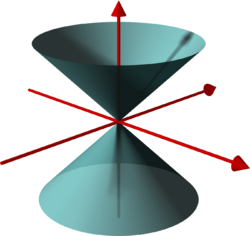Conical surface: Difference between revisions
→Special cases: add citation |
→Special cases: +1 source |
||
| Line 10: | Line 10: | ||
==Special cases== |
==Special cases== |
||
If the directrix is a circle <math>C</math>, and the apex is located on the circle's ''axis'' (the line that contains the center of <math>C</math> and is perpendicular to its plane), one obtains the ''right circular conical surface'' or [[Double cone (geometry)|double cone]].<ref name=msg/> More generally, when the directrix <math>C</math> is an [[ellipse]], or any [[conic section]], and the apex is an arbitrary point not on the plane of <math>C</math>, one obtains an [[elliptic cone]] |
If the directrix is a circle <math>C</math>, and the apex is located on the circle's ''axis'' (the line that contains the center of <math>C</math> and is perpendicular to its plane), one obtains the ''right circular conical surface'' or [[Double cone (geometry)|double cone]].<ref name=msg/> More generally, when the directrix <math>C</math> is an [[ellipse]], or any [[conic section]], and the apex is an arbitrary point not on the plane of <math>C</math>, one obtains an [[elliptic cone]]<ref name=young/> (also called a ''conical quadric'' or ''quadratic cone''),<ref name=osg>{{citation |
||
| last1 = Odehnal | first1 = Boris |
|||
| last2 = Stachel | first2 = Hellmuth |
|||
| last3 = Glaeser | first3 = Georg |
|||
| contribution = Linear algebraic approach to quadrics |
|||
| doi = 10.1007/978-3-662-61053-4_3 |
|||
| isbn = 9783662610534 |
|||
| pages = 91–118 |
|||
| publisher = Springer |
|||
| title = The Universe of Quadrics |
|||
| year = 2020}}</ref> which is a special case of a [[quadric|quadric surface]].<ref name=young>{{citation|title=Analytical Geometry|first=J. R.|last=Young|publisher=J. Souter|year=1838|page=227|url=https://archive.org/details/analyticalgeome00youngoog/page/n243}}</ref><ref name=osg/> |
|||
==Equations== |
==Equations== |
||
Revision as of 00:12, 27 January 2024

In geometry, a conical surface is a three-dimensional surface formed from the union of lines that pass through a fixed point and a space curve.
Definitions
A (general) conical surface is the unbounded surface formed by the union of all the straight lines that pass through a fixed point — the apex or vertex — and any point of some fixed space curve — the directrix — that does not contain the apex. Each of those lines is called a generatrix of the surface.[1]
In general, a conical surface consists of two congruent unbounded halves joined by the apex. Each half is called a nappe, and is the union of all the rays that start at the apex and pass through a point of some fixed space curve.[2] (In some cases, however, the two nappes may intersect, or even coincide with the full surface.)[3] Sometimes the term "conical surface" is used to mean just one nappe.[4]
Special cases
If the directrix is a circle , and the apex is located on the circle's axis (the line that contains the center of and is perpendicular to its plane), one obtains the right circular conical surface or double cone.[2] More generally, when the directrix is an ellipse, or any conic section, and the apex is an arbitrary point not on the plane of , one obtains an elliptic cone[5] (also called a conical quadric or quadratic cone),[6] which is a special case of a quadric surface.[5][6]
Equations
A conical surface can be described parametrically as
- ,
where is the apex and is the directrix.[3]
Related surface
Conical surfaces are ruled surfaces, surfaces that have a straight line through each of their points.[7] Patches of conical surfaces that avoid the apex are special cases of developable surfaces, surfaces that can be unfolded to a flat plane without stretching. When the directrix has the property that the angle it subtends from the apex is exactly , then each nappe of the conical surface, including the apex, is a developable surface.[8]
A cylindrical surface can be viewed as a limiting case of a conical surface whose apex is moved off to infinity in a particular direction. Indeed, in projective geometry a cylindrical surface is just a special case of a conical surface.[citation needed]
See also
References
- ^ Adler, Alphonse A. (1912), "1003. Conical surface", The Theory of Engineering Drawing, D. Van Nostrand, p. 166
- ^ a b Wells, Webster; Hart, Walter Wilson (1927), Modern Solid Geometry, Graded Course, Books 6-9, D. C. Heath, pp. 400–401
- ^ a b Krivoshapko, S. N.; Ivanov, V. N. (2015), "1.1.3 Conical surfaces", Encyclopedia of Analytical Surfaces, Springer, pp. 59–60, ISBN 9783319117737
- ^ Shutts, George C. (1913), "640. Conical surface", Solid Geometry, Atkinson, Mentzer, p. 410
- ^ a b Young, J. R. (1838), Analytical Geometry, J. Souter, p. 227
- ^ a b Odehnal, Boris; Stachel, Hellmuth; Glaeser, Georg (2020), "Linear algebraic approach to quadrics", The Universe of Quadrics, Springer, pp. 91–118, doi:10.1007/978-3-662-61053-4_3, ISBN 9783662610534
- ^ Mathematical Society of Japan, Ito, Kiyosi (ed.), Encyclopedic Dictionary of Mathematics, Vol. I: A–N (2nd ed.), MIT Press, p. 419
- ^ Audoly, Basile; Pomeau, Yves (2010), Elasticity and Geometry: From Hair Curls to the Non-linear Response of Shells, Oxford University Press, pp. 326–327, ISBN 9780198506256






